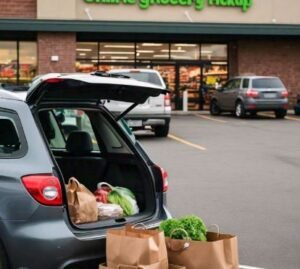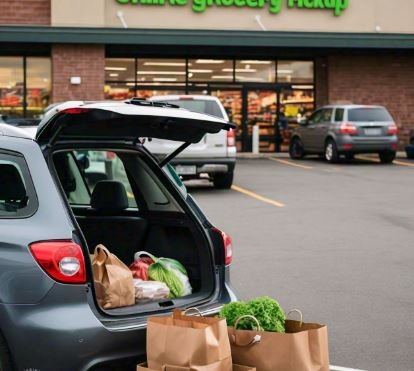In recent years, the ability to use Electronic Benefit Transfer (EBT) for grocery shopping has become a critical tool for many low-income individuals and families. With the rise of online grocery shopping and curbside pickup services, the question of states accepting EBT for grocery pickup has become increasingly relevant. While this option may seem like a game-changer for those who rely on EBT benefits, it’s important to examine whether states accepting EBT for grocery pickup is a helpful convenience or if it’s simply a limited service that doesn’t meet all needs.
This article will dive into the truth behind states accepting EBT for grocery pickup, explore the pros and cons of using this service, and provide insight into whether it’s a truly accessible and practical option for everyone.

What is EBT for Grocery Pickup?
First, let’s establish what it means when we talk about states accepting EBT for grocery pickup. EBT is a system used to distribute government benefits, like those provided by the Supplemental Nutrition Assistance Program (SNAP). Traditionally, these benefits were used for in-store grocery purchases, but with the advent of online shopping and grocery pickup, some states have started allowing recipients to use their EBT cards for these services.
When a state accepts EBT for grocery pickup, beneficiaries can place their grocery orders online, choose a convenient pickup time, and pay for the groceries using their EBT benefits. This service aims to provide more flexibility and convenience to those who may not have easy access to transportation or who face physical limitations.
The Benefits of States Accepting EBT for Grocery Pickup
- Convenience for Low-Income Families
One of the biggest advantages of states accepting EBT for grocery pickup is the convenience it offers. For families without a vehicle, those with limited mobility, or individuals who live in rural areas, this service can be a game-changer. It eliminates the need to physically go into a store, which can be time-consuming, exhausting, and sometimes impractical for those relying on EBT benefits.
- Improved Access to Fresh Food
By allowing EBT for grocery pickup, many states are making it easier for individuals to access healthy, fresh food. Online grocery services often offer the ability to choose from a wide selection of products, including fresh produce, meats, dairy, and pantry staples. In traditional grocery store settings, low-income individuals may face challenges like limited stock or higher prices, but EBT for grocery pickup can open up more options for healthier, fresher food choices.
- Safe and Easy Shopping
For seniors and individuals with health issues, going to a store can be physically demanding. The option of EBT for grocery pickup allows them to shop from the comfort of their own home, thus reducing exposure to crowds or harsh weather conditions. During events like the COVID-19 pandemic, this service has proven to be an essential tool for reducing the risk of exposure while still ensuring that people get the food they need.
- Streamlined Shopping Experience
When using EBT for grocery pickup, customers can easily browse through online menus, check prices, and avoid impulse buys, making it easier to stick to a budget. This streamlined shopping experience can be particularly helpful for those who need to carefully manage their limited benefits.
The Challenges and Limitations of States Accepting EBT for Grocery Pickup
While states accepting EBT for grocery pickup seems like a promising service, there are significant challenges and limitations that can make it less accessible or practical for everyone.
- Limited Availability Across States
Not every state offers the ability to use EBT for grocery pickup. While some states have made this service widely available, others still do not support it, leaving a large number of potential beneficiaries without this convenience. In states where EBT for grocery pickup is not available, recipients must rely on traditional in-store shopping, which may not always be feasible for them. This lack of uniformity in service offerings can create disparities in access to grocery shopping convenience based on geographic location.
- Restrictions on Eligible Items
Even in states that do accept EBT for grocery pickup, there are often limitations on the types of products that can be purchased using benefits. Typically, EBT for grocery pickup is restricted to food items that are eligible under the SNAP program. This means that non-food items, such as household goods, personal care products, or cleaning supplies, cannot be purchased with EBT, even if they are part of the pickup order. For customers who rely on EBT for grocery pickup, this can be an inconvenience, as they must make separate arrangements for these non-eligible purchases.

- Additional Fees for Pickup Services
While some grocery stores offer EBT for grocery pickup, many charge an additional fee for this service. This fee can range from a few dollars to more, depending on the retailer and location. For individuals relying on EBT benefits, this fee can add up, making the service less affordable or even inaccessible for those on tight budgets. Although some retailers waive fees for certain circumstances, such as during special promotions or for those with low incomes, the extra charges can be a significant deterrent.
- Technology and Internet Access Barriers
To take advantage of EBT for grocery pickup, recipients need access to a computer, smartphone, or tablet, as well as reliable internet access. For some senior citizens, low-income individuals, or those without stable internet service, this requirement can be a major barrier. These individuals may find it difficult or even impossible to use the online services, preventing them from benefiting from this convenience.
- Quality Control and Substitutions
Another common issue with EBT for grocery pickup is the possibility of substitutions. Because customers are not physically in the store, items they order may not be available, and the store will choose a substitute. However, this can lead to disappointment if the substitute is not suitable, either due to dietary restrictions or personal preferences. While most stores allow customers to reject substitutions, it can still be a frustrating experience that limits the value of EBT for grocery pickup.
Is EBT for Grocery Pickup the Future of Grocery Shopping?
The truth about states accepting EBT for grocery pickup is that, while it offers clear benefits, it also comes with limitations. It’s an incredibly helpful convenience for those who have the resources to access it, making grocery shopping more accessible and easier for many. However, the barriers that exist — such as limited state availability, restrictions on eligible items, additional fees, and technological challenges — can hinder its widespread adoption and effectiveness.
For EBT for grocery pickup to become a fully functional service that meets the needs of all low-income individuals and families, several improvements must be made. These might include expanding availability across all states, eliminating additional fees, ensuring equitable access to technology, and streamlining the product options available for pickup.

Conclusion: A Helpful Convenience or a Limited Service?
Ultimately, the question of whether states accepting EBT for grocery pickup is a helpful convenience or a limited service depends on the circumstances of each individual. For some, it’s a lifesaver — providing flexibility, improved access to healthy food, and a safer shopping experience. For others, the limitations of EBT for grocery pickup make it less of a practical option, leaving them with unmet needs and barriers to access.
As more states and retailers work to expand and improve EBT for grocery pickup, it’s likely that this service will evolve into a more accessible and equitable option for everyone. However, until those gaps are addressed, it remains a valuable but imperfect solution for many low-income households.




